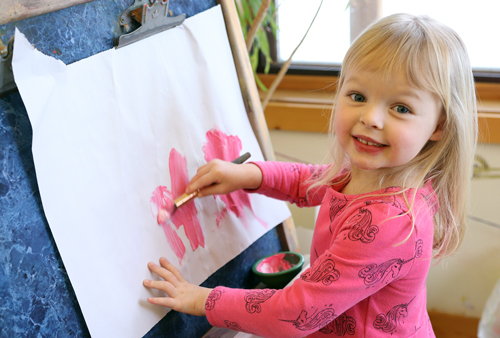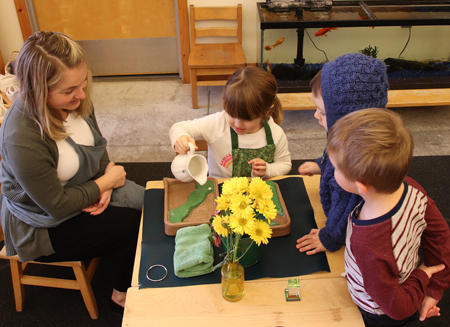 One of the most challenging parts of being a “Montessorian” is explaining the method to other people. We’ve all tried to come up with the perfect elevator speech and the most compelling case to sway a skeptic. However, it seems that most of the push-back is founded on misunderstandings. Among the points of contention is the idea that Montessori environments are too structured and don’t allow for creativity. It is true that Montessori materials are rooted in the real world rather than fantasy (research shows most children under five can not distinguish between what is real and imaginary); yet, a fundamental principle of the Montessori method is to value process over product.
One of the most challenging parts of being a “Montessorian” is explaining the method to other people. We’ve all tried to come up with the perfect elevator speech and the most compelling case to sway a skeptic. However, it seems that most of the push-back is founded on misunderstandings. Among the points of contention is the idea that Montessori environments are too structured and don’t allow for creativity. It is true that Montessori materials are rooted in the real world rather than fantasy (research shows most children under five can not distinguish between what is real and imaginary); yet, a fundamental principle of the Montessori method is to value process over product.
Creativity is defined as, “the use of the imagination or original ideas, especially in the production of an artistic work” (Oxford Dictionary). The clearest example of this is on a primary art shelf. We value the child’s process by choosing art mediums for them to explore rather than paint by number type crafts. Your primary child might bring home an easel painting from their Montessori environment but probably not a perfectly made snowman that looks just like the model an adult made. Where would the originality be in that? If a child didn’t come up with it themselves, they are not exercising their creative brain.
 The Montessori method is also inherently creative because we only provide children with the keys to the world. Rather than providing the child with every experience, we give them the sufficient minimum of information needed to learn the remaining elements on their own. For example, Montessori primary guides only directly teach six land and water forms so the child can independently discover the rest. They are given the opportunity to see a new water form in a book, research it and feel the joy that comes with unearthing new information. Similarly, children are invited to explore materials in new ways and even combine multiple materials as they innovate and imagine new possibilities. Our exact presentations are intentionally designed to be a jumping off point that pushes the child to exercise their creativity.
The Montessori method is also inherently creative because we only provide children with the keys to the world. Rather than providing the child with every experience, we give them the sufficient minimum of information needed to learn the remaining elements on their own. For example, Montessori primary guides only directly teach six land and water forms so the child can independently discover the rest. They are given the opportunity to see a new water form in a book, research it and feel the joy that comes with unearthing new information. Similarly, children are invited to explore materials in new ways and even combine multiple materials as they innovate and imagine new possibilities. Our exact presentations are intentionally designed to be a jumping off point that pushes the child to exercise their creativity.
So how can we support children’s creativity outside of school? Ask open-ended questions. Let children explore to answer questions on their own. Let them take risks and make mistakes. Allow them to problem solve. Allow children to complete a task in a different way. Accept imperfection and embrace imagination rooted in the real world.
In November 2019, Megan Andrews, Karin Church, and I attended a professional development workshop with Marc Brackett, founder and director of the Yale Center for Emotional Intelligence. The day reminded us of the importance of emotional intelligence and provided us with new ways to help our students learn about their emotions. We know that emotions impact learning and were reminded that there are no bad emotions and that emotions provide information. We can use that information to help ourselves and each other. Providing students direct instruction on how to Recognize, Understand, Label, Express, and Regulate emotions can help in many ways. This R.U.L.E.R. approach is the basis of Brackett’s work. If our kids can know and manage themselves and consider the perspectives of others, they may be able to make sound personal and social choices.
Being patient, responsive, and loving, while holding children to a high standard, is much easier if we as adults are able to manage, understand, and accept our own emotions and know that our emotional state will affect how we perceive a situation. Learning is a social activity and is most productive through collaboration. Maria Montessori gave us a solid foundation with many lessons on what she called grace and courtesy. Young children are shown how to quietly push in a chair, walk through the classroom without disturbing another child’s work, and even how to blow their nose. The Montessori curriculum at every level explicitly uses modeling and stories to teach social behavior. Children have many opportunities daily to collaborate with classmates and practice social skills. Older students act out social situations demonstrating successful or unsuccessful ways to interact with others. Adults tell stories hoping to inspire good deeds.
We learned that one in five American children will experience a mental health issue before they reach eighteen. By taking the time to get to know children and building strong relationships with them, we hope to help stem this tide. Greeting each student in the morning with a handshake, allowing time to discuss feelings, and guiding actions all help to build trusting caring relationships.